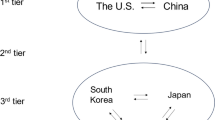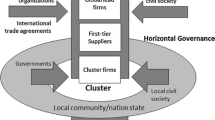Abstract—
In the article, based on the study of methodological ideas about assessing the state of economic security of the state, a system of indicators of the economic security of a regional integration association has been developed. This system includes three groups of indicators: assessments of the quality of life of the population, foreign trade interaction and competitiveness, and industrial production and cooperation. Based on the developed system of indicators, the state of economic security of the Eurasian Economic Union was studied and conclusions about the compliance or noncompliance of individual indicators with the established threshold values were drawn. In particular, it was noted that the indicators characterizing the quantitative and qualitative participation of the Eurasian Economic Union (EAEU) in the world trade in innovative industrial products are very low. Despite the industrial policy pursued by the governments of the member states of the integration association, aimed at developing innovative high-tech industrial production in the manufacturing sectors, in this regard, the problem of a high degree of dependence on imports from third countries is clearly visible. The data presented in the article indicate that the state of economic security of the EAEU is not ensured for any of the three groups of indicators. The situation is especially aggravated in terms of the state of the EAEU manufacturing industry development and the use of the domestic market potential.
Similar content being viewed by others

Notes
These indicators are given in a special section “Economic security” on the official website of EU statistics. https://ec.europa.eu/eurostat/databrowser/view/ilc_mdes04$-DV_421/default/table?lang=en.
REFERENCES
B. Buzan, People, states & fear: An agenda for international security studies in the Post-Cold War Era, ECPR Classics Series, 2007. https://www.academia.edu/4780500/People_States_and_Fear_An_Agenda_For_International_Security_Studies_in_the_Post_Cold_War_Era_Barry_Buzan.
O. Lavrinenko, A. Smirnov, and N. Jefimovs, “Assessment of social-economic security of administrative areas of Latvian municipalities,” J. Secur. Sustainability Issues 6 (2), 245–257 (2016). https://doi.org/10.9770/jssi.2016.6.2(5)
Economic Security of Russia: General Course: Textbook, 2nd ed., Ed. by V. K. Senchagov (Delo, Moscow, 2005) [in Russian].
S. Yu. Glaz’ev, “The basis for ensuring the economic security of the country—An alternative reformation course,” Vopr. Ekon., No. 2, 3–18 (1997).
S. N. Sil’vestrov, V. G. Starovoitov, and A. V. Larionov, “Development of a system for monitoring the implementation of the economic security strategy in the Russian Federation,” Nats. Interesy: Prioritety Bezop. 16 (12), 2202–2217 (2020).
J. S. Hacker, et al., The economic security index: A new measure for research and policy analysis, IZA Discussion Papers, No. 6946 (Inst. Stud. Labor, Bonn, 2012). https://www.researchgate.net/-publication/3272563-93_The_Economic_Security_Index_A_New_Measure_for_Research_and_Policy_Analysis.
L. Osberg and A. Sharpe, “How should we measure the ‘economic’ aspects of well being?,” Review of Income and Wealth 2 (51), 311–336 (2005).
J. Stiglitz, J. Fitoussi, and M. Durand, Beyond GDP: Measuring What Counts for Economic and Social Performance (OECD, Paris, 2018).
P. K. Singh and B. N. Hiremath, “Sustainable livelihood security index in a developing country: A tool for development planning,” Ecol. Indic. 10 (2), 442–451 (2010).
V. Ioan-Franc and M. A. Diamescu, “Some opinions on the relation between security economy and economic security,” Rom. J. Econ. 2 (40), 122–159 (2010).
S. Yu. Glaz’ev and V. V. Lokosov, “Evaluating extremely critical indicators of the state of Russian society and managing socioeconomic development with them,” Herald Russ. Acad. Sci. 82, 229–245 (2012).
S. Yu. Glaz’ev, “On urgent measures to strengthen the economic security of Russia and bring the Russian economy to the trajectory of advanced development,” Nauchn. Tr. Vol'nogo Ekon. O-va Ross. 196 (7), 86–186 (2015).
V. K. Senchagov, “Economic security of Russia,” EKO 395 (5), 2–22 (2007).
J. Pinder, “European economic security: How can we master the modern economy?,” Int. J. 40 (1), 128–144 (1984/1985).
L. Sineviciene, O. Shkarupa, and L. Sysoyeva, “Socio-economic and political channels for promoting innovation as a basis for increasing the economic security of the state: Comparison of Ukraine and the countries of the European Union,” Socio-Economic challenges (SEC) 2 (2), 81–93 (2018).
Final Report of the Expert Group on Quality of Life Indicators (Publications Office of the European Union, Luxembourg, 2017). https://ec.europa.eu/eurostat/documents/7870049/7960327/KS-FT-17-004-EN-N.pdf/f29171db-e1a9-4af6-9e96-730e7e11e02f?t=1-490716665000.
W. Glatzer, “Quality of life in the European Union and the United States of America: Evidence from comprehensive indices,” Appl. Res. Qual. Life 1 (2), 169–188 (2006).
I. V. Andronova, I. N. Belova, M. V. Ganeeva, N. P. Gusakov, O. B. Digilina, N. V. Dyuzheva, K. N. Elikbaev, N. M. Ivanova, S. N. Lavrov, M. F. Mizintseva, E. V. Pak, I. B. Teslenko, L. N. Fedyakina, B. A. Kheifets, V. Yu. Chernova, and M. A. Chavykina, Economic Security of the EAEU (Ross. Univ. Druzhby Narodov, Moscow, 2020) [in Russian].
V. K. Senchagov and E. A. Ivanov, The Structure of the Mechanism of Modern Monitoring of Russia’s Economic Security (Inst. Ekon. Ross. Akad. Nauk, Moscow, 2015) [in Russian].
V. V. Krivorotov, A. V. Kalina, and I. S. Belik, “Threshold values of indicative indicators for diagnosing the economic security of the Russian Federation at the present stage,” Vestn. Ural. Fed. Univ., Ser. Ekon. Upr. 18 (6), 892–910 (2019). https://doi.org/10.15826/vestnik.2019.18.6.043
Author information
Authors and Affiliations
Corresponding author
Ethics declarations
The authors declare that they have no conflicts of interest.
Rights and permissions
About this article
Cite this article
Pak, A.Y., Andronova, I.V. Assessment of the State of Economic Security of Regional Integration Associations on the Example of the Eurasian Economic Union. Stud. Russ. Econ. Dev. 34, 329–334 (2023). https://doi.org/10.1134/S1075700723030115
Received:
Revised:
Accepted:
Published:
Issue Date:
DOI: https://doi.org/10.1134/S1075700723030115



